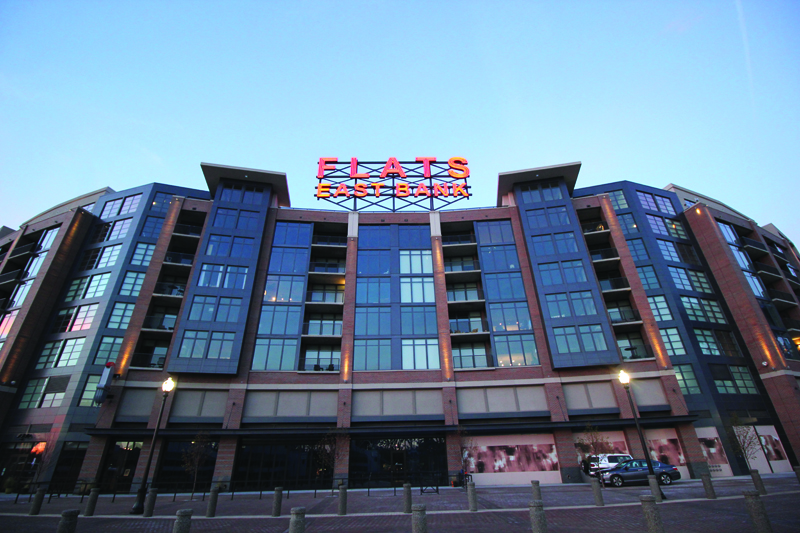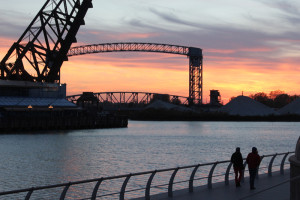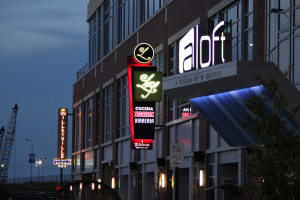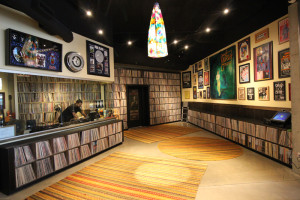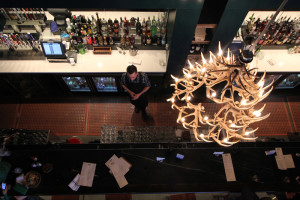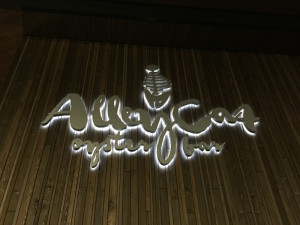With Phase II in the books, the Flats East Bank – long in the works – is beginning to reverse the fortunes of downtown Cleveland’s riverfront
Story by Carlo Wolff
Photography by Michael C. Butz
There’s a shiny new neighborhood in Cleveland, familiar ground repurposed for a fresh population. It’s the Flats East Bank, and it includes apartments, offices and restaurants. And where this waterfront district was associated primarily with entertainment in the last 30 years, it is becoming known for much more than that. At least that’s the plan, say principals in the $750 million, multiphase project, already years in the making. So far, phases I and II have been completed, but there is more to come. Wolstein Group principal Scott Wolstein, who shepherded the ambitious, complex effort with his mother, Iris, and Adam Fishman, a principal in Fairmount Properties, says building it out could take another eight years.
Which is fine with him: the Flats East Bank holds a special place in Scott Wolstein’s heart. It’s his father Bart’s vision made flesh in concrete, steel, wood, glass – and
water.
- Flats East Bank has reintroduced walking along the Cuyahoga River to many Greater Clevelanders.
- Flats East Bank Phase I businesses like Lago East Bank and Aloft Downtown Cleveland add to the district’s neighborhood feel.
- At a Phase II ribbon cutting ceremony were, from left with scissors, Cleveland City Councilman Joe Cimperman, Cleveland City Council President Kevin Kelley, Cuyahoga County Executive Armond Budish, Cleveland Mayor Frank G. Jackson, Iris Wolstein, Scott Wolstein and Adam Fishman.
- Crop Rocks is home to about 20,000 records, which people can request be played by someone in the radio booth.
- A birds-eye view at Punch Bowl Social.
- Zack Bruell’s Alley Cat Oyster Bar and Punch Bowl Social join Phase I businesses like Lago East Bank and Aloft Downtown Cleveland in transforming Flats East Bank into a destination neighborhood.
The new look
Two years ago, Phase I of the project was unveiled, its key structures an 18-story office building occupied by accounting firm Ernst & Young (recently rebranded as EY) and a limited-service, super-contemporary 150-room aloft hotel. While they raised and modernized Cleveland’s profile, they seemed almost lonely and lacking in context.
Now they “lead” to the new phase, which is dominated by a huge, architecturally striking apartment building shaped like a horseshoe.
And now that the Wolstein Group and Fairmount have completed that 241-unit centerpiece of Phase II, sporting a prominent “Flats East Bank” at its crest, a sense of neighborhood is beginning to take hold, much as it has in Ari Maron and MRN Ltd.’s Uptown development at University Circle and their groundbreaking, mixed-use revitalization of East Fourth Street, effectively Cleveland’s Restaurant Row.
The Flats East Bank is indeed a sight to behold and experience, especially when its pathways are filled with scores of people going from one attraction to the next or to and from the nearby Rapid stop along the Greater Cleveland RTA’s Waterfront Line.
The district is newly walkable and watchable, with a 1,200-foot boardwalk especially dear to Iris Wolstein, a gang of restaurants including Steve Schimoler’s Crop Rocks and Crop Sticks, Zack Bruell’s Alley Cat Oyster Bar, a fitness center, and even a dueling piano bar (The Big Bang).
The area enthralls Bruell, who sprinkles Cleveland with restaurants (11 and counting, including this waterfront debut). He says it succeeds because of a key draw: the Cuyahoga River, which bisects the Flats, a storied entertainment destination that went seedy decades ago.
“The view is incredible,” Bruell says of the vista available from the deck of his industrially styled seafood eatery.
“It’s almost like a movie set, and it’s not something that I created. We’re facing the water, we’re facing Shooters (a West Bank restaurant), and there’s barges coming by that I don’t know how long they are but they’re very long and they’re moving very slow, there’s rowers coming by, boats coming by … it is a rebirth, and that’s what this project is: the rebirth of that part of the river.”
Alley Cat business has been great from the start. “We opened up on Aug. 1 and we’ve been packed right out of the gate,” Bruell says, noting his is the first oyster bar in Cleveland. “It could have been the location but it was the location and the asset.”
To Iris Wolstein, it’s not just location; it’s finish – both psychological and aesthetic. She says her husband, Bertram L. “Bart” Wolstein, was “very, very civic-minded and wanted Cleveland to blossom like so many other cities that had projects on the water.”
Bart Wolstein, a noted developer and philanthropist, died in 2004.
The Wolsteins began assembling Flats East Bank parcels in the mid-’80s, when the city had become “stagnant,” Iris says. Putting land and financing together took 25 years; no shovels broke ground until 2010. Now, a neighborhood is rising.
It’s a striking one, at least partially thanks to Iris, who loves that boardwalk.
“I worked with the layout and the design and the selection of finishes and furniture,” she says. “Then I worked with the project manager and the landscaper on the layout of all the exterior landscaping. That’s my job,” she adds, laughing.
“I’m very proud of the boardwalk because I selected different-looking railings than the standard boardwalk look. When I select items I’m always concerned with maintenance as well as appearance.”
The railings are brushed stainless steel with a wood cap on top. She chose that blend because brushed stainless steel “picks up the light and it’s very clean-looking.”
The way it was
In the early ’90s, the area was rich with bars: D’Poo’s, Fagans, Rumrunner’s, Circus Circus, Kindler’s. Fifteen years earlier, Pirate’s Cove was an incubator of Cleveland’s bristly punk rock scene, and in the late ’80s, the district boasted such selfie magnets as Tangerine Farley’s and the new wave club Aquilon.
At the start of that decade, after graduating from law school at the University of Michigan in Ann Arbor, Scott Wolstein made the Flats his hang.
“When I was young, I spent every summer down in the Flats, where most of my social life revolved around,” Scott recalls, citing use of a speedboat he used to store in various places including a rack near the late-lamented Jim’s Steak House.
Scott used his speedboat to navigate the Flats, which he suggests was his playground. He recalls that in the early ’80s, the area became trendier, with clubs like the Basement, the Playdium, Peabody’s DownUnder, and the Beach Club.
There were 40 to 50 bars, restaurants and clubs, “and everybody’s social life revolved around there – there were a lot of venues that had live music, lots of different restaurants … there was a pretty eclectic mix of things.” The good, bad and the ugly cohabited; strip joints bellied up to snazzy riverfront decks, with downscale and upscale in easy relationship.
Redevelopment began as Scott and his parents began a protracted effort to amass all 23 acres of what is now called the Flats East Bank.
The process was fitful and political, Scott suggests.
In the mid-’90s, when Mike White was mayor, White began to pull Cleveland police out of the Flats “because he didn’t see a lot of black people down there and he wanted to provide police protection in their neighborhoods,” Scott says.
That security shift gave “license to the bad element to set up shop,” he adds, citing an influx of motorcycle gangs “and unsavory characters, and they pushed all the good people up to the Warehouse District.” So the Wolsteins, shopping center moguls who made their fortune in real estate as owners of Developers Diversified, decided to buy up the entire district, bounded by West 9th Street to the east, the Cuyahoga River to the west, Main Avenue to the South and railroad tracks to the north.
They wanted to control the environment, says Scott, noting 23 acres is “an extremely large site to be able to consolidate in an urban area.”
“We got involved because of our affection for it, and then we saw we needed to do this to realize the vision and to protect our investment,” he says. “If it didn’t get fixed, our investment was in jeopardy.
“We needed government to provide us eminent domain power and create an economic development district, and that brought everybody to the table because they knew they would have to sell it.”
An open invitation
Ten years ago, when the Wolsteins contacted Fishman, the Fairmount Properties executive, to join them in their multitiered mixed-use effort, the offer signified not only a business deal. It touched Fishman because it involved “a part of Cleveland where I sort of grew up.”
His father ran Midwest Bakery Products, a 7,000-square-foot cinderblock building on Elm Street in the Flats, and Fishman used to spend his summers working there. The area was more industrial than entertainment-oriented then. It represents his childhood.
“I was truly honored that the Wolstein family would even consider young Fairmount Properties to be their partner, and it was very personal to have a chance to do something in the city that I love,” he says.
“The Wolsteins envisioned this as a live-work-play waterfront destination. I embraced their vision, and how that manifested itself, how that actually came to be, is something I was very much involved in day to day because we had to react to market forces. Global market conditions, like the 2008 meltdown, devastated this project.”
From 2008 to 2010, the project effectively went dormant, kept alive by the Wolsteins’ capital and commitment, says Fishman.
The Wolstein Group and Fairmount Properties assembled what he calls the “most complicated public-private partnership” in the region over those two years, crafting a
$280 million purse to construct Phase I, the Ernst & Young Tower and the Aloft Cleveland Downtown. More than 30 sources of capital are involved in that stack.
“What we’ve done is much better than what was before: nothing but a playground and entertainment district,” says Scott Wolstein. “Now it’s a neighborhood; when you have stakeholders, they’re 24/7. You don’t have the same threat of a bad element coming in.”
His father’s fondest hope was “to create an upscale neighborhood of a movie theater, bars and restaurants, what have you,” says Scott. “I don’t think he ever envisioned the office building and hotel component for the project. But opportunities evolve as the market changes.
“I think his greatest aspiration was to try to get the public to lock arms with him on a shared vision. That’s probably the aspect of what we’ve been able to achieve he’d probably be most pleased with.”
To Fishman’s father, the Flats was a place to go to work. To Fishman, it was a place for play, for rites of passage – and for some time, a place in decline.
“And for kids now,” says Fishman, “it’s a place where people come down and they can’t believe this is our city. So now it’s defining our waterfront as a place to live, work and play and just be. That is the psychic benefit we as developers get: we’ve transformed a part of the city we all love for the better.
“The whole country is talking about what’s happening in downtown Cleveland. I wish more people would come downtown to see what they’re talking about.” js
Three cheers for the Flats
By Carlo Wolff
Now that the first two phases are complete, plans are underway for Phase III, which could include “a lot more housing,” a movie theater with customizable dining options, some boutiques and additional restaurants, says Adam Fishman.
“I think we’d love to see 1,000 residential units there, and we’d probably have about 350,000 square feet of retail,” says Scott Wolstein, noting the project already features an office building and a hotel.
“We just take it one step at a time; we’ll take whatever the market will endure. Each phase usually takes a couple of years from start to finish,” Wolstein says, adding he thinks the Wolstein Group and Fairmount Properties will keep developing the site for another six to eight years.
Also on the horizon is a Cleveland Metroparks-proposed water taxi, which if it comes to fruition, would serve to connect entertainment districts on both sides of the Cuyahoga River. js

